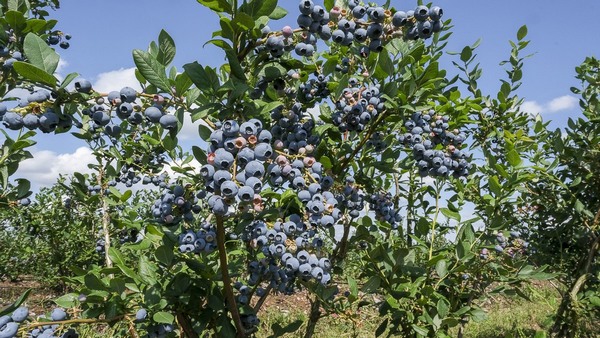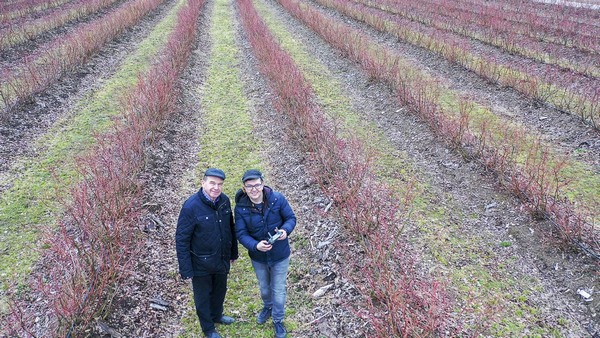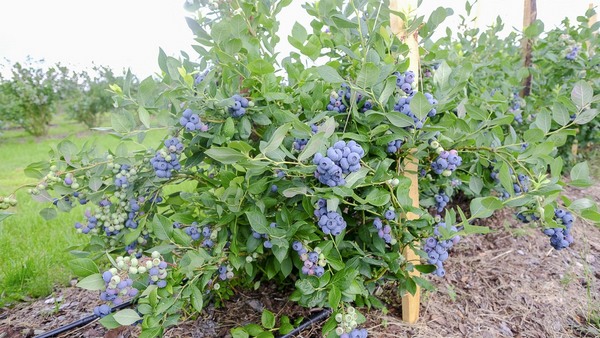"This is an issue that many growers are currently facing. It concerns new adepts who are establishing blueberry plantations and experienced ones who start restructuring their farms. Is it possible to answer the question unequivocally? Probably not, but it is worth knowing the opinion of people who are experts in the blueberry industry."
"The climate of most European countries makes it possible to cultivate varieties of the northern type, which are characterized by a fairly high resistance to low temperatures in winter, as well as a large chilling requirement necessary for proper formation of flower buds and fruiting. In this regard, the varieties can be divided into two types: high chill (require 800-1000 hours of cool) and low chill (150-800 hours of cool weather). Varieties from the first group have dominated blueberry plantations in Europe.
"The most popular are Bluecrop, Chandler, Bluegold, Liberty, Toro, Spartan, Patriot, Aurora, which have been cultivated for many years now. Among the new breeding creations, this group includes such varieties as Megasblue, Titanium, Cargo, Calypso, Valor, Last Call. A large part of the new varieties already belongs to the mid chill group, which means that they require fewer hours of coolness, but may also be susceptible to freezing during winter, especially when temperatures below -15-20°C occur. The group of mid chill varieties includes such varieties as Drapper, Top Shelf, Peachy Blue or Orsorno. A separate group are the low chill and no chill varieties, which are intended for cultivation in warm climates, where there is no risk of temperature drops below 0 ° C."

"Taking into account current customer requirements and possible future trends in this area we have to expect that the requirements of blueberry customers will only grow. The modern consumer wants varieties which fruit taste well and are durable, and the supermarket wants varieties that the consumer will be happy to come back for. These are the challenges of blueberry growers around the world and it is one of the key points if we want to talk about the future of this specie in professional and intensive cultivation," says Krzysztof Żabówka, Managing Director of Daifressh Berry.
Will the expectations be met? Breeders offer more and more new varieties, which however, are not immediately accepted by producers. "It is important to assess the production values of a given variety and check how they perform in the local climate. We are constantly looking for the perfect variety of blueberries, but as long as it is difficult to find one," says Jerzy Wilczewski, owner of a farm in Białousy (Poland, Podlasie), where blueberries are grown on 600 ha. The production of blueberries in this farm is already based on "new generation" varieties such as Last Call, Cargo, Calypso, Draper, although there are such varieties as Liberty, Aurora, Duke and other older varieties (gradually replaced with new ones) cultivated. Each variety has its advantages and disadvantages.

"Liberty is good and fertile, but its fruit is too soft, Chandler has beautiful and large fruit, but too soft for export, Aurora has hard but too acidic fruit," says a grower from Białous. Most of the fruit from this farm is produced for export, so they have to be hard, firm, durable, but also aromatic, nicely colored and with bloom. Much depends on the variety, but it is also the treatment and management of the plantation that matters. In this farm, much attention is paid to pruning (this must be well performed, predominance of young shoots), but also to other agrotechnical treatments that affect the quality of the fruit (fertilization, protection).
In recent years, the quality requirements for blueberries have been very basic (size, color) or even minimal. The blueberry was just a "blue ball" packed in a small bag or a plastic container. "Now that's not enough! Today's blueberries must meet quality requirements to be the product that people want to eat, retailers want to sell, and growers can thrive on. Although each of these groups has different goals and priorities, the overall goal is common - really high and repeatable fruit quality, thanks to which it is possible to develop the entire industry and prosper on the market," emphasizes Andrea Pergher from Fall Creek Farm & Nursery. This American company is a leader when it comes to breeding new blueberry varieties (especially varieties of the northern type). The latest breeding creations ('FC11-118', 'Cargo', 'Blue Ribbon', Top Shelf, 'ArabellaBlue', 'Last Call', 'LunaBlue' (FC12-205), 'PeachyBlue' (ZF08-029)) meet the needs of the modern market.

"So, let’s try to answer the title question? It is very difficult. The new blueberry varieties seem to be very attractive because they ensure high-quality fruit (size, crunchiness, hardness, taste, shelf life). Usually new creations are easy in cultivation and can be harvested with harvesters (erect, vertical shoots). It is necessary to check and observe them in individual growing regions. This year, when in many areas of Eastern Europe the temperatures dropped below -30°C, it will be possible to assess such an important feature of the new varieties as frost resistance. As soon as we collect this information, we'll share it with you soon."
"Meanwhile, we invite you to learn more about blueberry cultivation during the XIX International Highbush Blueberry Conference (online). This event offers a lot of practical information in the area of agrotechnics and plantation management (this year we have prepared a 5-hour fertilizing block), but also allows a broader look at the blueberry business. It will also allow you to plan your blueberry business well for the coming years."
For the full agenda for the Blueberry Conference 2021, please click here.
For more information:
Mariusz Podymniak
Tel: +48 608 500 501
Email: mariusz.podymniak@hortusmedia.pl
